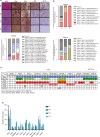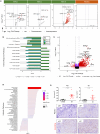Induction of p53-mediated apoptosis by azacitidine in patient-derived xenograft follicular helper T-cell lymphoma model
- PMID: 40394210
- PMCID: PMC12208902
- DOI: 10.1038/s41375-025-02628-0
Induction of p53-mediated apoptosis by azacitidine in patient-derived xenograft follicular helper T-cell lymphoma model
Abstract
Follicular helper T-cell lymphoma (TFHL) is the most common non-cutaneous T-cell lymphoma in the Western world and is associated with a poor prognosis. Neoplastic cells rely heavily on the tumor microenvironment, demonstrated by the absence of TFHL-derived cell lines, which hinders therapeutic progress. To overcome this limitation, we developed and characterized patient-derived xenograft TFHL (TFHL-PDXs). Fifteen TFHLs were implanted into immunodeficient mice, generating nine PDXs. The tumor microenvironment was detected in the first passage but progressively disappeared in subsequent passages. TET2 mutations persisted in all cases and TFHL-specific mutations were observed in most. The models were treated with azacitidine and patient sensitivity was fully recapitulated. To elucidate the mechanism of action of azacitidine, we analyzed the differences in DNA methylation and gene expression in six TFHL-PDX models. Global DNA hypomethylation occurred in azacitidine-treated cells in drug-sensitive models but not in the resistant ones. DNA hypomethylation was associated with global upregulation of gene expression, including that of various cancer-related pathways, suggestive of p53-pathway-mediated cytotoxicity. Overall, the PDXs recapitulated TFHL features and exhibited sensitivity to azacitidine. They also made it possible to decipher the mechanism responsible for the effect of azacitidine, revealing the activation of p53-mediated apoptosis associated with DNA hypomethylation.
© 2025. The Author(s).
Conflict of interest statement
Competing interests: GT, SAY, AF, MC, AC, NS, CR, JN, AG, DLM, MHDL, VA, RS, and PG have no conflict of interest to declare. FL has received a research grant from BMS and Roche, a travel grant from Roche, Gilead, and Abbvie, and honoraria grants from Takeda and AstraZeneca. FL is on the advisory board of Miltenyi, Kyowa Kirin, and BMS.
Figures





Similar articles
-
Anti-cancer drug sensitivity testing and preclinical evaluation of the anti-cancer potential of WEE1 inhibitor in triple-negative breast cancer patient-derived organoids and xenograft models.Breast Cancer Res. 2025 Jun 23;27(1):113. doi: 10.1186/s13058-025-02063-0. Breast Cancer Res. 2025. PMID: 40551232 Free PMC article.
-
Chimeric antigen receptor (CAR) T-cell therapy for people with relapsed or refractory diffuse large B-cell lymphoma.Cochrane Database Syst Rev. 2021 Sep 13;9(9):CD013365. doi: 10.1002/14651858.CD013365.pub2. Cochrane Database Syst Rev. 2021. PMID: 34515338 Free PMC article.
-
A rapid and systematic review of the clinical effectiveness and cost-effectiveness of paclitaxel, docetaxel, gemcitabine and vinorelbine in non-small-cell lung cancer.Health Technol Assess. 2001;5(32):1-195. doi: 10.3310/hta5320. Health Technol Assess. 2001. PMID: 12065068
-
Follicular helper T-cell lymphomas with EBV-positive neoplastic cells: a rare scenario with diagnostic implications.Mod Pathol. 2025 Aug 26:100875. doi: 10.1016/j.modpat.2025.100875. Online ahead of print. Mod Pathol. 2025. PMID: 40876773
-
Rituximab for the first-line treatment of stage III-IV follicular lymphoma (review of Technology Appraisal No. 110): a systematic review and economic evaluation.Health Technol Assess. 2012;16(37):1-253, iii-iv. doi: 10.3310/hta16370. Health Technol Assess. 2012. PMID: 23021127
References
-
- Laurent C, Baron M, Amara N, Haioun C, Dandoit M, Maynadié M, et al. Impact of expert pathologic review of lymphoma diagnosis: study of patients from the French Lymphopath Network. Journal Clin Oncol. 2017;35:2008–17. - PubMed
-
- de Leval, Rickman L, Thielen DS, Reynies C, de A, Huang YL, et al. The gene expression profile of nodal peripheral T-cell lymphoma demonstrates a molecular link between angioimmunoblastic T-cell lymphoma (AITL) and follicular helper T (TFH) cells. Blood, J Am Soc Hematol. 2007;109:4952–63. - PubMed
-
- Lemonnier F, Couronné L, Parrens M, Jaïs JP, Travert M, Lamant L, et al. Recurrent TET2 mutations in peripheral T-cell lymphomas correlate with TFH-like features and adverse clinical parameters. Blood, J Am Soc Hematol. 2012;120:1466–9. - PubMed
MeSH terms
Substances
Grants and funding
LinkOut - more resources
Full Text Sources
Research Materials
Miscellaneous

